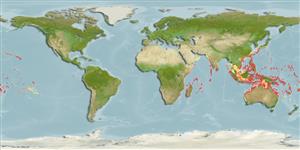Classification / Names
Common names from other countries
Main reference
Size / Weight / Age
Max length : 32.0 cm TL male/unsexed; (Ref. 90102)
Length at first maturity
Lm 11.0, range 19 - ? cm
Environment
Marine; reef-associated; depth range 0 - 50 m (Ref. 9710), usually ? - 20 m (Ref. 5222)
Climate / Range
Tropical, preferred ?; 35°N - 35°S, 28°E - 129°W (Ref. 5222)
Distribution
Short description
Dorsal
spines
(total): 11;
Dorsal
soft rays
(total): 15-17;
Anal
spines: 3;
Anal
soft rays: 8. A series of about five darker diagonal bands, each two to five hexagons wide, superimposed on sides and radiating from eye; hexagons on sides may coalesce into short rows (Ref. 37816); further characterized by having ctenoid scales on body except cycloid anteriorly above lateral line, on thorax and lower abdomen; body with auxiliary scales; greatest depth of body 2.8-3.3 in SL; rounded caudal fin; pelvic fins, 1.7-2.2 in head length (Ref. 90102); head length 2.3-2.6 times in SL; flat interorbital area, dorsal head profile convex; rounded or subangular preopercle, serrae at angle enlarged; almost straight upper edge of operculum; subequal anterior and posterior nostrils or posterior nostrils larger; maxilla reaches past vertical at rear edge of eye; 2-4 rows of teeth on midlateral part of lower jaw, inner teeth about twice length of outer teeth; pyloric caeca 8 (Ref. 89707).
IUCN Red List Status (Ref. 115185)
Threat to humans
Reports of ciguatera poisoning (Ref. 30298)
Human uses
Fisheries: commercial; aquaculture: commercial; gamefish: yes; aquarium: public aquariums
More information
ReferencesAquacultureAquaculture profileStrainsGeneticsAllele frequenciesHeritabilityDiseasesProcessingMass conversion
Tools
Special reports
Download XML
Internet sources
Estimates of some properties based on models
Phylogenetic diversity index
PD50 = 0.5000 many relatives (e.g. carps) 0.5 - 2.0 few relatives (e.g. lungfishes)
Trophic Level
3.8 ±0.0 se; Based on diet studies.
Resilience
High, minimum population doubling time less than 15 months (K=0.3-0.6)
Vulnerability
Low to moderate vulnerability (29 of 100)
Price category
